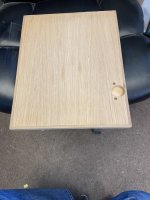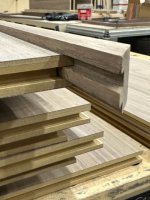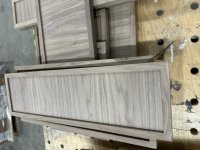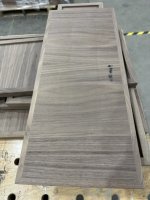I like this look:

https://superiorcabinets.ca/trends/slim-shaker-cabinets-are-not-a-trend/
According to the article, the MDF doors are made from 7/8” thick MDF which his CNC machined to create a 1/16” reveal.
The wood doors have a 1/8” reveal.
I can envision several ways to make this. I could cut an L-shaped molding 7/8” thick with a 1/8” thick lip on one end and maybe 3/8” on the other side.
Or I can take a 7/8” x 3/4” strip of wood and take a tiny slice off one side of the 7/8” height leaving 1/8” at the top. The small lip would make registration easy.
I could simply glue a 7/8” x 3/4” strip around the perimeter of the door/drawer front. The drilled cup from the cup hinge would slide partially through that wider strip around the perimeter.
I have a tongue and groove router bit set. I could cut the groove in the center and the tongue on the rails and stiles. That would make for a stronger glue up.
I suspect that there is some incredibly easy way to do this or why are the cabinet makers pushing this design?
I don’t have access to a CNC machine and 7/8” thick MDF would be impossible to find anyhow.
Any ideas?
This guy just glues a strip around the perimeter of the board using a band clamp. I dont like that. It only clamps the corners and does not guarantee good contact along the perimeter,

https://superiorcabinets.ca/trends/slim-shaker-cabinets-are-not-a-trend/
According to the article, the MDF doors are made from 7/8” thick MDF which his CNC machined to create a 1/16” reveal.
The wood doors have a 1/8” reveal.
I can envision several ways to make this. I could cut an L-shaped molding 7/8” thick with a 1/8” thick lip on one end and maybe 3/8” on the other side.
Or I can take a 7/8” x 3/4” strip of wood and take a tiny slice off one side of the 7/8” height leaving 1/8” at the top. The small lip would make registration easy.
I could simply glue a 7/8” x 3/4” strip around the perimeter of the door/drawer front. The drilled cup from the cup hinge would slide partially through that wider strip around the perimeter.
I have a tongue and groove router bit set. I could cut the groove in the center and the tongue on the rails and stiles. That would make for a stronger glue up.
I suspect that there is some incredibly easy way to do this or why are the cabinet makers pushing this design?
I don’t have access to a CNC machine and 7/8” thick MDF would be impossible to find anyhow.
Any ideas?
This guy just glues a strip around the perimeter of the board using a band clamp. I dont like that. It only clamps the corners and does not guarantee good contact along the perimeter,





